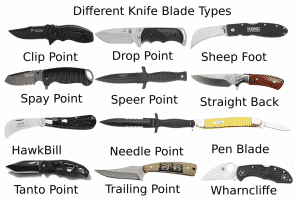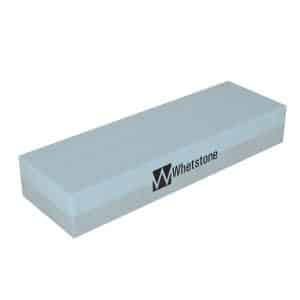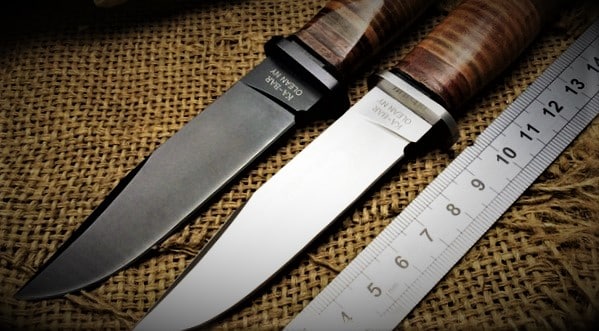If I could only have one piece of equipment in a survival situation it would have to be a knife. With a good knife you can make just about anything you need. You’ll be able to find shelter, make tools and get food with primitive traps. With a little bit of practice you’ll turn into a many your forefathers would be proud of. While they seem similar you’re going to want a different survival knife as opposed to hunting knife. Most survival knives are larger and heavier than your typical hunting knife. But what makes a knife suitable for a life or death situation? I’ve already shown you my favorite survival knives but how do you choose one?
How to Choose a Survival Knife?
Different Knife Designs
There are a ton of different knife styles as seen in the photo below, but which one makes up the best survival knife. The knife needs to have a full length tang that runs all the way through the knife. The Backbone like tang can serve as a hammer in a survival situation. There are a number of folding knives that can work well, but you can never go wrong with a fixed blade. Personally I would always bring a fixed blade knife on any wilderness retreat. That being said the perfect knife is the one you’re willing to carry. It might make sense to carry a full sized USMC Kabar on a camping trip, but you’d look silly with one at the office. If all you’re comfortable carrying is a pocket knife that’s better than nothing. What good is a knife that never leaves your bedside table.

The blade needs to have a sharp point and good slicing ability. Try and find a good balance between the serated and flat edged side. That’s why so many people love the Ka-Bar fixed blade knife to the right. It has the perfect amount of serration to be effective without reducing its slicing capability. You’ll still be able to quickly skin animals, filet fish whereas the serration will help you cut through limbs and harder objects.
The back of the blade needs to have a thick hardened spine that can be used as a hammer. You don’t want your knife bending or getting damaged when you’re lost in the woods. It will really help you when doing random chores like splitting firewood and or cutting through tree branches.
Keep Your Knife Sharp
Make sure your knife is sharpened often and stays sharp. A dull knife will make tasks much more difficult and dangerous. Dull blades increase your chances of slipping and cutting yourself. It’s your responsibility to keep your knife sharp with a sharpening stone or knife sharpener.
Safety Tip: A properly sharpened knife can easily slice your finger which could be serious in a survival situation. Cheap knives are often more dangerous than they’re worth. You need to respect your blade and always follow safe handling procedures.
Different Knife Metals
The blade of a survival knife needs to be made out of a tough edge holding steel. It needs to resist rust and corrosion to keep a sharp edge. Knife metallurgy is constantly evolving producing thicker and stronger steel. There are so many different types of metal that it can be difficult to choose the right one. Midway’s knife steel and handle material chart should set you in the right direction.
Choose The Right Grip
It’s difficult to foresee what you’ll need in a given survival situation. I always plan for the worst and expect a lot of mud and moisture. You’re going to need to find a knife that isn’t slippery when wet. Manufacturers use a lot of tricks to make their blades easier to handle. They use aggressive checkering patterns and finger contours to increase your grip. You also need to make sure the grip is durable enough to take a pounding when you need it. You’ll need to try a few knives to get a feel for them. I really like the durability and comfort of wooden grips, but rubber might offer more comfort.
 Don’t Be tempted With Oversized Knives
Don’t Be tempted With Oversized Knives
Maybe you’re Crocodile Dundee’s younger brother, but I’m certainly not. While Dundee’s oversized knife may work for him it’s ridiculous for most people. The only time bigger knives are beneficial is when used as a hatchet. The added weight makes it much easier to cut. You can use it for digging and as a pry bar also, but that will quickly wear out a blade. If you need to do a lot of digging use the knife to create a crude wooden shovel.
There’s a reason the Marine Corps chose the Ka-Bar knife as their go to blade. Through extensive testing they found that it offered the perfect size to strength ration. Use the Ka-Bar as a guide and find a knife that fits your specific needs. A little bigger or smaller can work better in some situations. A large bowie knife is going to be difficult to wield, but you’ll lose a lot of leverage on a smaller blade.
Always Use a Sheath
The right sheath is almost as important as the blade itself. You’ll need some form of protective sheath to both protect yourself and the blade. Years ago on one of my first hiking trips I brought along a 20$ blade I found at tractor supply. The blade was impressive and fit all my needs, but it came with a cheap nylon sheath. Of course three days into the hike it went through the sheath and cut my leg pretty badly. I ended up wrapping it in a few dirty shirts and storing it in my hiking backpack. After the trip I had my Amish Farrier design a heavy duty leather holster that includes a sharpening stone. It cost me less the $20 and has lasted close to 15 years.
Get Your Practice In
Just because you spent a ton of time picking out the perfect knife doesn’t mean your an outdoorsman. You can’t assume that you’re an expert just because you have the equipment. Make sure you always use proper knife safety and practice in a controlled setting. Always cut away from yourself and make sure its functional before you get out in the field.

